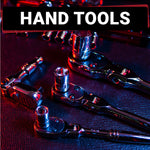
Are you looking for the best ratcheting wrench sets on the market? They are major labor savers and have features that you simply can’t have with regular wrenches.
You can find multiple types of ratcheting wrenches in the market that have 72, 100 and even 120 teeth. Do these numbers really matter? We’ll answer this question and tell you the most important features to help you make the most educated choice when buying your ratcheting wrench set.
Ratcheting Wrenches Tooth Count
When looking for the best ratcheting wrench set for the job, the tooth count is a decisive factor, as this defines how far you need to swing the handle to engage the ratchet pawls and turn the fastener. In simple words, the greater the number of teeth this tool features, the less you’ll need to move the wrench to apply torque; delivering the most optimal results by helping you to remove or install the fastener quicker and with less effort.
A 36 tooth ratcheting wrench allows for an 10 degree swing arc. On the contrary, a 100 tooth ratcheting wrench only requires a 3.6 degree of swing arc that allows you to work on tight spots. The Olsa Tools upcoming ratcheting wrench set features not 100, but 120 teeth. This 120-tooth ratcheting wrench set allows you great control over the tool, as it requires only 3.0 degrees of swing arc, meaning that you can tighten and loosen nuts and bolt in the tightest of spaces. Although you can find higher-tooth-count ratcheting mechanisms (e.g., with 144 teeth), this is commonly found in socket wrenches (or ratchets) instead of ratcheting wrenches. Does this mean you need both a socket wrench and a ratcheting wrench set? If you are a DIYer, I would suggest you wait and buy the tool you require until you get ready for the project. But if you’re a professional mechanic, it’s more likely that you require both sets of tools as you are constantly working on multiple projects.
Fixed or Flex Head, Stubby or Long-reach?
The wrench design has two important features: the style of the head and the length of the handle. Both have their benefits; a flex head ratcheting wrench can be angled through 90 degrees or 180 degrees, depending on the brand, which allows it to get to those spaces with awkward angles; this is something that their cousins, fixed head ratcheting wrenches can’t do. However, under extreme torque application, it is not convenient to use a flex head ratcheting wrench; this tool has an extra failure point that can cause accidents and make you waste time.
For those projects when space is so limited and precise that you simply can’t reach the fastener with a regular ratcheting wrench, is where a stubby ratcheting wrench shines brightest. Thanks to the length of the handle, you can apply higher torque in the bare minimum amount of clearance. With Olsa Tools future sets, you'll have both, a 120 Tooth Ratcheting Wrench Set, and a 120 Tooth Stubby Ratcheting Wrench Set that come with fixed or flex heads. You can choose the best ratcheting wrench set that will help you work easier and faster in those situations where you need an elevated degree of precision.
What’s The Best Ratcheting Wrench Set For You?
Now that you know that 120 and 100 tooth ratcheting wrenches can help you work more precisely, does this mean that it is the best one? The answer is no. In the world of tools, it is all about preferences for different applications. Sometimes the best ratcheting wrench set is one with 72 teeth and on occasions, it is the 120 tooth ratcheting wrench set. The most convenient product helps you complete the job right with the minimum amount of effort. All of these Olsa Tools ratcheting wrench sets come in both metric and SAE sizes, and we are so confident about them that they are backed by a limited lifetime warranty, 100% satisfaction guarantee and a 90-day free return policy to give you more peace of mind with every purchase.













